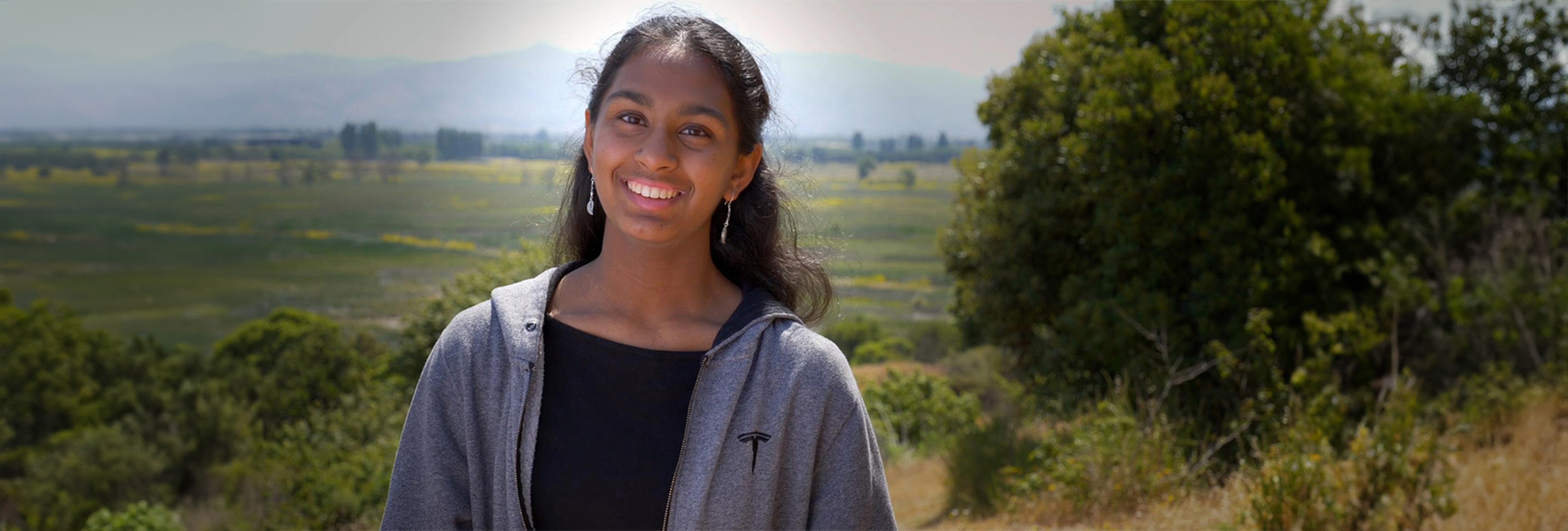(October 31, 2024) In 2015, California faced one of its most severe droughts, and Shreya Ramachandran was only a middle school student when she first witnessed its devastating impact. A visit to Tulare County during an archery competition made her confront the harsh reality of water scarcity. Residents’ wells had run dry, forcing them to rely on water trucks for basic needs like drinking and bathing. “It was shocking to see this happening so close to home,” says Shreya, now a Stanford University senior studying Human Biology. But this wasn’t the first time she had encountered the devastating effects of water scarcity. Growing up, Shreya frequently visited her grandparents in India, where access to clean water was a daily struggle for many. The brown, muddy water that sometimes came out of the taps, or the long lines at water tankers, was the norm in her grandparents’ village.
These experiences ignited a determination in Shreya to take action. She wanted to find solutions to the water crisis, not just in her community but globally. “Two-thirds of the world’s population live without access to clean drinking water for at least one month each year,” she explains, referencing a study by Mekonnen and Hoekstra. With climate change worsening the situation, Shreya knew she wanted to be part of the solution.

Shreya Ramachandran
Shreya’s passion led her to explore water conservation, and soon she found her focus—greywater reuse. Greywater, the lightly used water from sinks, showers, and laundries, is a resource that many overlook. But Shreya saw its potential. According to the Environmental Protection Agency’s WaterSense program, a significant portion of household water—between 30 percent and 50 percent—is used for outdoor purposes, primarily watering lawns. Shreya realized that greywater could be reused for irrigation, reducing the burden on clean drinking water.
Driven by this idea, Shreya began experimenting. She discovered soap nuts, natural fruits used for centuries in countries like India for their soap-releasing properties. For five years, Shreya conducted extensive research on the environmental impact of soapnut greywater, testing its effects on soil, plants, and aquatic life. Her results showed that soapnut greywater was safe for irrigation, paving the way for its use as an eco-friendly solution to water wastage.
But Shreya didn’t stop there. In 2016, at the age of 13, she founded The Grey Water Project, a nonprofit organization dedicated to raising awareness about greywater reuse and water conservation. “People didn’t know about greywater. Some viewed it as dirty or unsanitary,” she says, reflecting on the early challenges of spreading her message. However, Shreya was determined to change the narrative. Through her nonprofit, she began hosting workshops, giving presentations, and creating a STEM curriculum for schools to teach students about water recycling and conservation.
A Changemaker in the Bay Area
Shreya’s journey with The Grey Water Project quickly gained momentum. Today, her efforts have impacted over 100,000 people across the globe. She’s held workshops, developed educational programs for schools, and even advocated for greywater policy changes at the government level. “It’s incredible to see people implementing greywater systems in their homes after attending one of our workshops,” Shreya says proudly.


Her work also led her to serve as a youth representative on her city’s Environmental Sustainability Commission, where she’s helping shape the future of climate and water policies.
The Bay Area, home to one of the largest Indian diaspora communities in the U.S., has long been a hub of innovation and social action. For Shreya, this environment has been key to her growth. “I’ve always felt a deep connection to my heritage and my community here,” she says. The Indian community in San Francisco has been integral to supporting her initiatives, offering her the space and encouragement to pursue her passion. Growing up between two worlds—California and India—gave Shreya a unique perspective on water issues, allowing her to draw parallels between the challenges faced by communities in both regions.
Shreya’s work also speaks to a larger trend within the Indian diaspora—one of giving back and creating impact, not just in their home countries but globally. “We’re all connected by thsese issues,” she says. “Water scarcity is a global crisis, and it’s something that unites people across borders.”
From Stanford to Global Solutions
Currently a senior at Stanford University, Shreya Ramachandran is focusing on the intersection of climate and health as part of her Human Biology degree. “It’s fascinating to see how closely the environment and human health are linked,” she shares. Her academic pursuits only fuel her passion for finding real-world solutions to global challenges. At Stanford, Shreya is part of Stanford Climate Ventures and leads Students for Sustainable Stanford’s Climate Action Group, continuing her advocacy for water conservation and climate policy.
View this post on Instagram
But perhaps what sets Shreya apart is her ability to turn classroom knowledge into actionable change. “What I’m learning at Stanford is helping me become a more effective leader,” she says, pointing to the skills she’s gained in environmental policy, entrepreneurship, and advocacy. Her work with The Grey Water Project allows her to bridge theory with practice, demonstrating the power of youth activism in addressing critical issues like water scarcity.
A Call to Action
Shreya Ramachandran’s journey is a powerful reminder that individual actions can spark global change. Through The Grey Water Project, she has not only raised awareness about water scarcity but has provided practical solutions that anyone can implement. As she continues to advocate for water conservation, Shreya emphasizes the role that each person plays in solving this crisis. “Conserving water starts with us,” she says.
Her message is clear: while governments and industries must play their part, individuals have the power to create change in their own homes and communities. As climate change continues to exacerbate water shortages around the world, Shreya’s work with greywater recycling offers a glimpse of hope for a more sustainable future.
As Shreya looks ahead, she remains optimistic. “We have the solutions,” she says. “It’s just about making them accessible to everyone.” And with young changemakers like Shreya leading the way, the path to water sustainability seems more achievable than ever.





